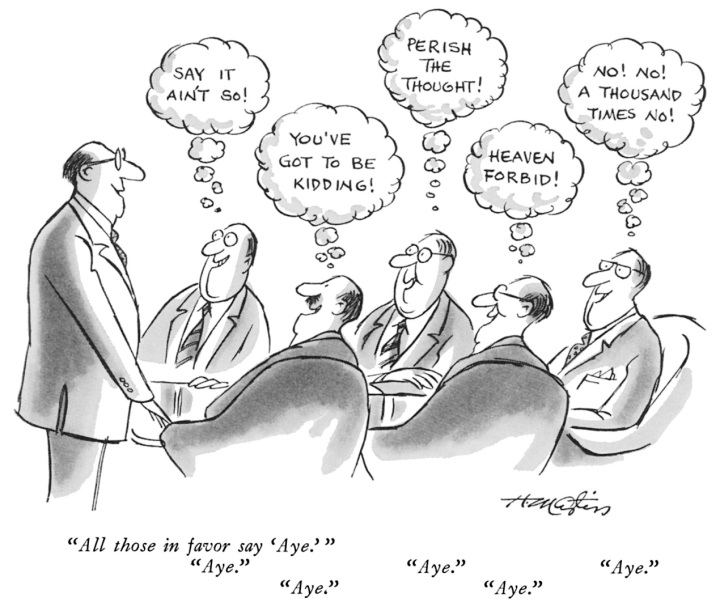Post provided by Nibedita Mukherjee (author of The Delphi technique in ecology and biological conservation)
The quirky nature of decision making
Two heads are often better than one in decision making. Several heads might have an even higher probability of being better than one. However, people in a group often have different modes of thinking or problem solving, alternate reference frames, subjective biases and varying levels or domains of expertise. How do we harness these messy thought processes and channel them for effective decision-making for biodiversity management?

So, what’s the solution?
A large number of psychological biases impact the outcomes of group based decision-making. Some of these biases (such as ego effect and dominance) can be addressed to a large extent by using an anonymous process. Individuals can focus on the problem or issue at hand rather than be distracted by allied interpersonal issues of conformity. They are far less likely to be influenced by the opinion of others and can thereby think independently. That’s a great start to improve the efficiency of decision making.
Another way to improve the efficiency would be to use an iterative process with feedback. Research in the past has shown that feedback and iteration have a considerable impact in refining the initial estimates. This is particularly important in uncertain or complex situations. Providing written feedback also makes the process more traceable for legal purposes. Iteration allows respondents to consider the problem for a longer period of time and learn from others in a controlled interactive setting.
Et voila! The Delphi technique
Combine these ingredients: anonymity, iteration and feedback, and the Delphi technique emerges! The Delphi technique originated in the 1950s and has been extensively used in many disciplines including medicine, psychology, nursing and tourism. However, it is rather underused in biodiversity sciences and holds considerable potential for further use.
The Delphi technique is a structured, anonymous and iterative survey of a panel of ‘experts’ or participants. It can be used for a variety of purposes ranging from generating consensus on controversial issues to formulating or evaluating policies relevant to conservation. The Delphi technique works best in situations where there might be strongly polarized opinions (such as human-wildlife conflict) that are difficult to resolve in face-to-face settings. It allows participants to explore (or expose) assumptions or information leading to divergent judgments and is thereby useful for complex issues that require pooling of inputs from different disciplines. If conducted online, the Delphi technique allows collation of inputs from different geographic locations within limited time and with minimal cost as well.
Data gaps are rather common in ecology. The Delphi technique can be used to fill in data gaps or validate models through experience of the participants. For instance Gobbi et al. (2012) used the Delphi technique to identify 229 invertebrate species that were either endangered or of ‘mandatory conservation interest’ for which detailed empirical data were lacking. Similarly, Hess and King (2002) used the Delphi technique as an expert based approach to develop a plan for wildlife conservation. They employed it to identify focal species for conservation in a sub-urbanizing region in North America (specifically North Carolina, USA). Experts identified six landscape types and nine focal species through this method.
Caution!
The Delphi technique is however not suitable where the respondent size is very large (several hundreds) or when a face to face discussion is essential. Neither should the Delphi technique be used as a substitute for quantitative data when it is readily available. Selecting experts and identifying the level of consensus is rather vital to the Delphi technique and the recent article in Methods in Ecology and Evolution provides some guidelines for addressing these issues.
Final verdict
The Delphi technique is indeed most suited to decisions or views that cannot (solely) be based on established facts, but demand interpreting complex and conflicting information. It is also highly useful for topics with a large degree of uncertainty or for issues that are strongly influenced by societal debate and require an unpressured approach by experts in anonymity. If applied well, the Delphi technique can be a useful addition to the toolkit of decision makers for bridging the gap between science and policy.
References
Gobbi, M., Riservato, E., Bragalanti, N. & Lencioni, V. (2012) An expert-based approach to invertebrate conservation: Identification of priority areas in central-eastern Alps. Journal for Nature Conservation, 20, 274-279.
Hess, G.R. & King, T.J. (2002) Planning open spaces for wildlife I. Selecting focal species using a Delphi survey approach. Landscape and Urban Planning, 58,16.
This post has been provided by Nibedita Mukherjee of the University of Cambridge. You can read her paper ‘The Delphi technique in ecology and biological conservation: applications and guidelines’ in Early View now.

2 thoughts on “The Delphi Technique: Unleashing the Power of Structured Collaboration in Anonymity”